A couple are reddish in colour and some are brighter but that is probably the camera or phone.
-
Please join our new sister site dedicated to discussion of gold, silver, platinum, copper and palladium bar, coin, jewelry collecting/investing/storing/selling/buying. It would be greatly appreciated if you joined and help add a few new topics for new people to engage in.
Bullion.Forum

You are using an out of date browser. It may not display this or other websites correctly.
You should upgrade or use an alternative browser.
You should upgrade or use an alternative browser.
Beekeeping
- Thread starter Lesgold
- Start date

Help Support Prospecting Australia:
This site may earn a commission from merchant affiliate
links, including eBay, Amazon, and others.
- Joined
- May 5, 2017
- Messages
- 3,839
- Reaction score
- 7,736
Was about to say that they are cleaning house up for the queen,
Goody
Goody
Spot on Megsy. Youve done it again. We must always assume that the bees know what is happening in their own backyard. We are just the visitors trying to read into what they already know. When I checked the hive yesterday, I found no evidence of a laying queen. It could have meant that no queen was created by the hive at the time of the split or perhaps the queen was killed on her mating flights. The other option is that a queen is present but has not started laying yet. After spotting the polished cells, I was a little more confident that the young worker bees were in fact preparing clean cells for the queen to lay in. This is not always 100% correct but I felt quite confident in this case. The other indicators were that the bees were working in an orderly fashion rather than walking around as if they were lost. The hive was also reasonably quiet. A hive that is queenless is often much noisier. The poor things are stressed and upset. To cover all bases, I decided to add a frame of eggs and young larvae to the hive. If the hive has a queen, the bees will raise the young as they normally would. If the hive is queenless, they may want to creat a queen cell from one of the eggs. It doesnt always turn out smelling of roses but often the technique works.
Cheers for now
Les
Cheers for now
Les
- Joined
- May 5, 2017
- Messages
- 3,839
- Reaction score
- 7,736
Well done Megsy :Y:
Goody
Goody
Yeah, well done Megsy.
Mackka 8.( 8.( 8.( 8.(
Just kidding
Mackka 8.( 8.( 8.( 8.(
Just kidding
- Joined
- May 8, 2014
- Messages
- 1,866
- Reaction score
- 2,449
Edit, just saw Megsys answer now, well done.
Thanks Megsy. Will leave the hive alone for about a week. When the hive is opened, hopefully there will be eggs present or a queen cell formed. Will keep you informed.
Cheers
Les
Cheers
Les
Well done Megsy. 

I actually wondered why they were polished clean.
The dark colour from previous use threw me.
Les, I have to say it publicly.
Many Thanks for introducing and educating us on
this fascinating subject.
You called me out for hooking you on a new idea.
I have told SHMBO that it is all your fault now. layful:
layful:
I actually wondered why they were polished clean.
The dark colour from previous use threw me.
Les, I have to say it publicly.
Many Thanks for introducing and educating us on
this fascinating subject.
You called me out for hooking you on a new idea.
I have told SHMBO that it is all your fault now.
- Joined
- Sep 10, 2018
- Messages
- 1,779
- Reaction score
- 3,943
I just wish I could get into this hobby - I'm loving this thread, learning all about these fascinating little critters.
I have two small problems though... I live in a unit with no yards to speak of - and I'm allergic to bee stings...
I have two small problems though... I live in a unit with no yards to speak of - and I'm allergic to bee stings...
Good onya Tathradj,
Im generally in the sh#t, its only the depth that varies. Happy to wear it though, especially to see someone else get into this enjoyable pastime. Hmmm, an interesting problem you present there Megsy. A difficult one to answer. At least you have the interest and some understanding of how the hive environment works. Hopefully you love eating the product of a bees hard work.
Cheers
Les
Im generally in the sh#t, its only the depth that varies. Happy to wear it though, especially to see someone else get into this enjoyable pastime. Hmmm, an interesting problem you present there Megsy. A difficult one to answer. At least you have the interest and some understanding of how the hive environment works. Hopefully you love eating the product of a bees hard work.
Cheers
Les
- Joined
- Sep 10, 2018
- Messages
- 1,779
- Reaction score
- 3,943
Here's a question for consideration...
I was standing out the front of work today, when I saw something moving and walked closer to see what it was on the path.
I was horrified to see it was a European wasp repeatedly stinging a bee that died, then the wasp flew away.
Could these mongrels be causing the decline in bee numbers? European wasps are very widespread in very large numbers now.
Could they be killing off the bees?
I was standing out the front of work today, when I saw something moving and walked closer to see what it was on the path.
I was horrified to see it was a European wasp repeatedly stinging a bee that died, then the wasp flew away.
Could these mongrels be causing the decline in bee numbers? European wasps are very widespread in very large numbers now.
Could they be killing off the bees?
- Joined
- May 8, 2014
- Messages
- 1,866
- Reaction score
- 2,449
MegsyB007 said:I just wish I could get into this hobby - I'm loving this thread, learning all about these fascinating little critters.
I have two small problems though... I live in a unit with no yards to speak of - and I'm allergic to bee stings...
You're a good buzz though
I tell people to remember my first name
as the bloke with the shovel.
Only the depth varies. O
Doug
as the bloke with the shovel.
Only the depth varies. O
Doug
Lesgold said:Good onya Tathradj,
Im generally in the sh#t, its only the depth that varies. Happy to wear it though, especially to see someone else get into this enjoyable pastime. Hmmm, an interesting problem you present there Megsy. A difficult one to answer. At least you have the interest and some understanding of how the hive environment works. Hopefully you love eating the product of a bees hard work.
Cheers
Les
Here's some pics of what I suspected was a queenless swarm I collected about this time last year. How that happens,? don't ask me cause i don't know enough about them.
I wasn't confident they would survive when I packed them into a super. I checked them a few months later and lo and behold I found a queen cell and lots of proof of life. Check out all that pupae.
They are very protective of their hive but I still robbed them not too long ago.

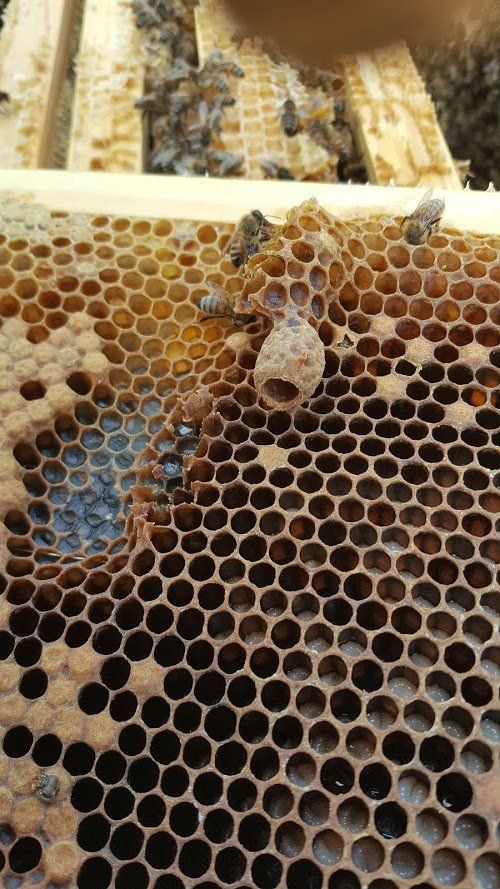

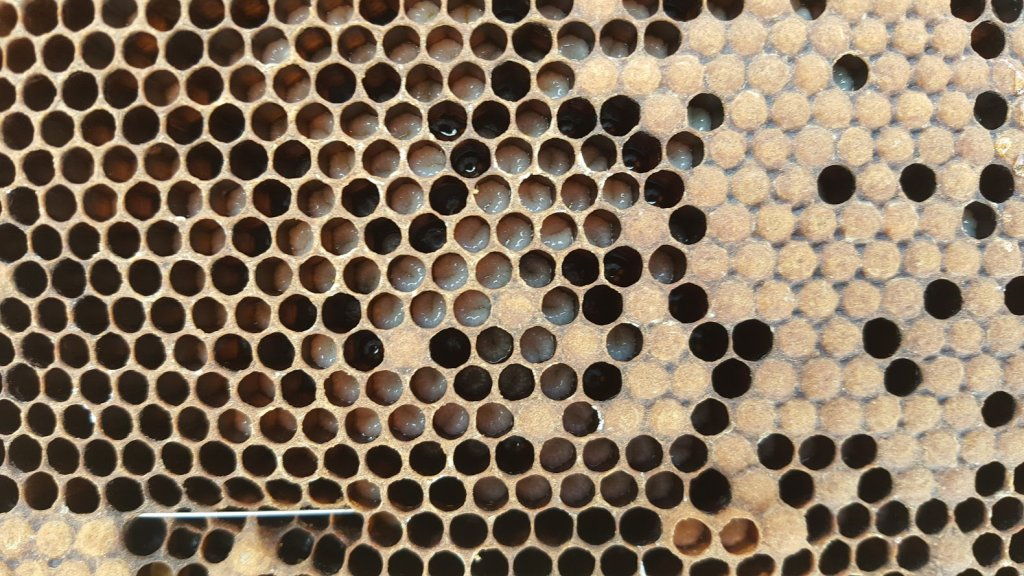

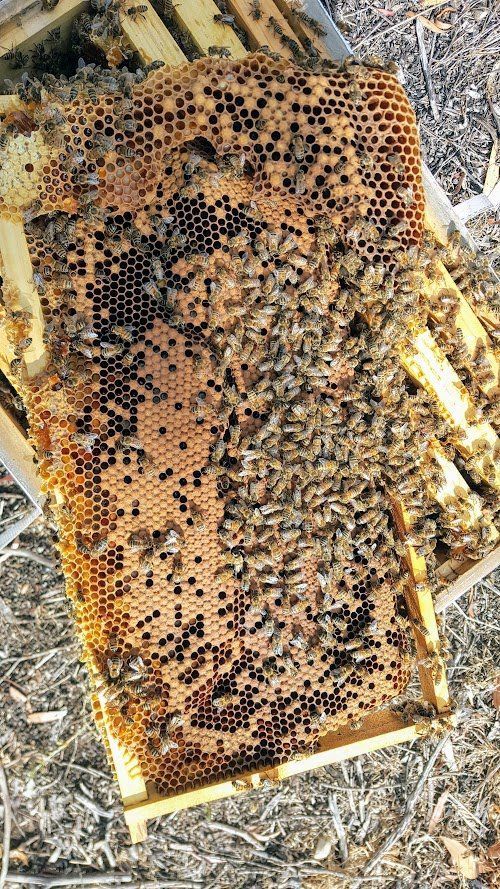
I wasn't confident they would survive when I packed them into a super. I checked them a few months later and lo and behold I found a queen cell and lots of proof of life. Check out all that pupae.
They are very protective of their hive but I still robbed them not too long ago.






Tathradj said:No idea Les.
I reckon you should write a book for the Hobbyist.
Yes me too!
I'll buy your 1st copy off the press......signed, of course
That queen looks like shes laying well Hard Luck. They surprise you at times dont they. Could be a good hive to keep. Is it coincidence or do the cranky hives always seem to produce more honey? The only problem with the agro bees is that they work harder to find ways of getting at you. Not much fun, especially if you are allergic. Megsy, if a bee and a wasp were having a blue, Id back the wasp every time. Wasps coming anywhere near a hive wouldnt stand a chance due to the numbers game. I reckon the wasps would get an absolute flogging. Gpx, I struggle to sign my name let alone write a book. Good to know if I did, two copies would be sold. You beauty, Im rich. Lol. Will put up some more info in a couple of days when this rain clears.
Cheers
Les
Cheers
Les
Hi Folks,
Thought Id better post a bit of information about the structure within a hive. Most people have a two or three deck hive (a brood box at the bottom which contains the queen, followed by a queen excluder and then one or two boxes or supers on top which will contain the honey) If a hive is contained within one box, the bees will establish a particular order to how the frames are managed. Lets take the single deck hive below as an example.
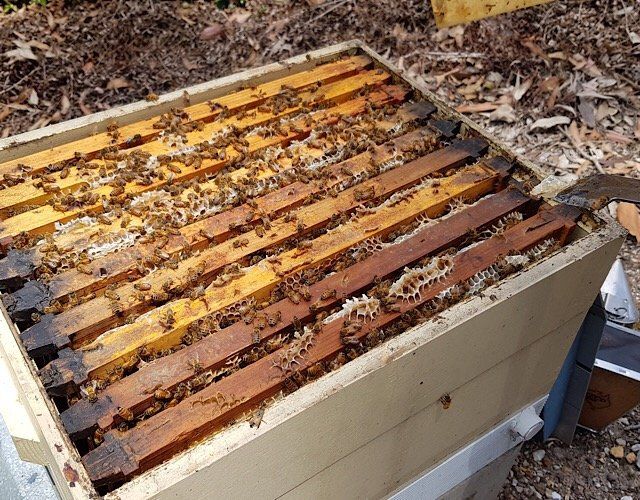
In this newly established hive, the bees have put honey only into the two outside frames.

You can see that there is nothing on or in this frame apart from honey. You may also notice that the top half of the frame is already capped which means that the bees have reduced the moisture content sufficiently to store the honey. Potentially this honey could remain unspoilt by bacteria for thousands of years as sugars in high concentrations are natural preserving agents. As long as moisture is kept away from the honey, it will keep extremely well. This honey will be used to feed young brood and the colony. It will provide the energy or carbohydrates that the bees need. (Especially through the winter when nectar is scarce.) The next frame in from the outside of the box contains some honey and quite a lot off pollen.

The young bees need protein and this is obtained from the pollen. You can see in the pic. that the pollen is packed in quite tight. Nurse bees mix pollen with nectar or honey and feed it to the young brood to promote growth. The remaining frames in the centre of the hive contain brood. The queen is constantly laying eggs and filling all available cells. When the brood reach the appropriate age, the cells are capped. Bees will then emerge about 21 days after the egg was laid.
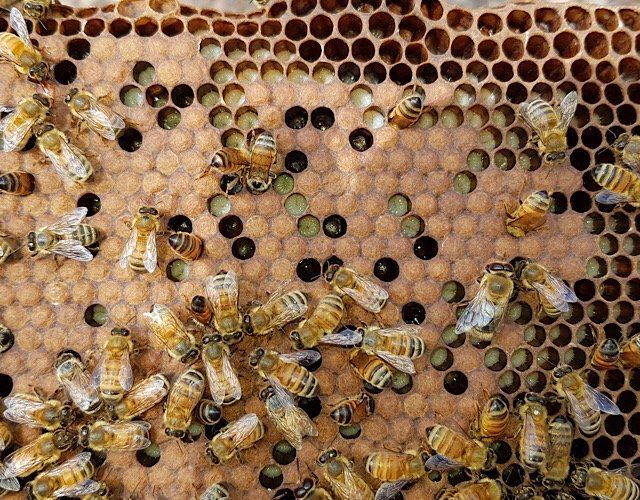
You can see capped and uncapped brood in the photo. In the wild, a hive would always try to reproduce this structure. Honey on the outside, brood in the middle and pollen in between. In other words, food is stored as close as possible to the brood nest. Most beekeepers use this structure to advantage. By confining a queen to one or two lower boxes, the bees naturally want to store the honey above the brood nest as the queen is using most of the lower frames to produce young.
Cheers for now,
Les
Thought Id better post a bit of information about the structure within a hive. Most people have a two or three deck hive (a brood box at the bottom which contains the queen, followed by a queen excluder and then one or two boxes or supers on top which will contain the honey) If a hive is contained within one box, the bees will establish a particular order to how the frames are managed. Lets take the single deck hive below as an example.

In this newly established hive, the bees have put honey only into the two outside frames.

You can see that there is nothing on or in this frame apart from honey. You may also notice that the top half of the frame is already capped which means that the bees have reduced the moisture content sufficiently to store the honey. Potentially this honey could remain unspoilt by bacteria for thousands of years as sugars in high concentrations are natural preserving agents. As long as moisture is kept away from the honey, it will keep extremely well. This honey will be used to feed young brood and the colony. It will provide the energy or carbohydrates that the bees need. (Especially through the winter when nectar is scarce.) The next frame in from the outside of the box contains some honey and quite a lot off pollen.

The young bees need protein and this is obtained from the pollen. You can see in the pic. that the pollen is packed in quite tight. Nurse bees mix pollen with nectar or honey and feed it to the young brood to promote growth. The remaining frames in the centre of the hive contain brood. The queen is constantly laying eggs and filling all available cells. When the brood reach the appropriate age, the cells are capped. Bees will then emerge about 21 days after the egg was laid.

You can see capped and uncapped brood in the photo. In the wild, a hive would always try to reproduce this structure. Honey on the outside, brood in the middle and pollen in between. In other words, food is stored as close as possible to the brood nest. Most beekeepers use this structure to advantage. By confining a queen to one or two lower boxes, the bees naturally want to store the honey above the brood nest as the queen is using most of the lower frames to produce young.
Cheers for now,
Les
Similar threads
- Replies
- 11
- Views
- 1K
- Replies
- 1
- Views
- 343


